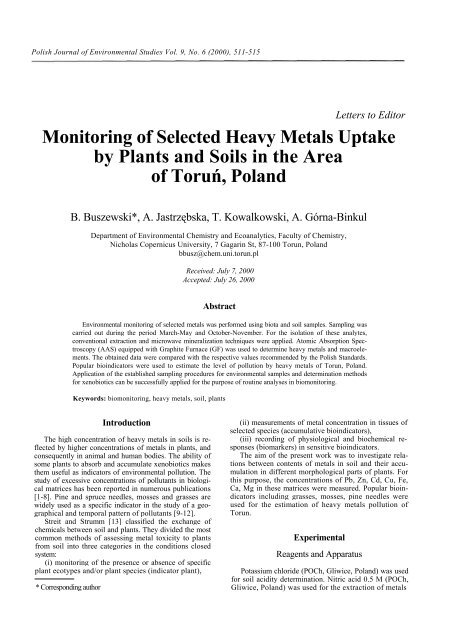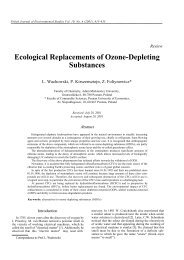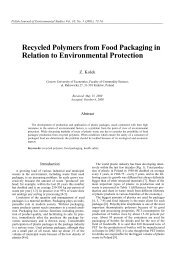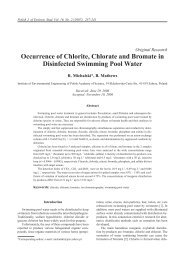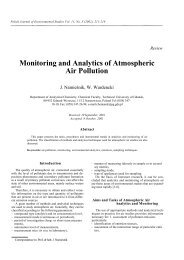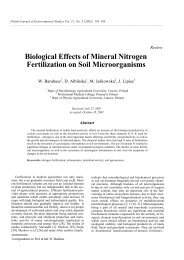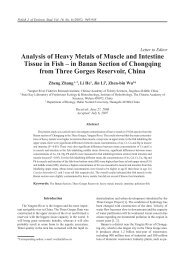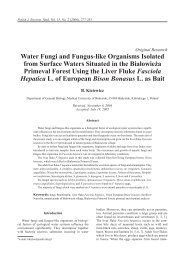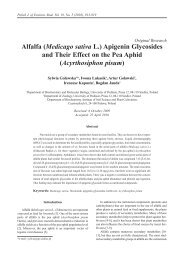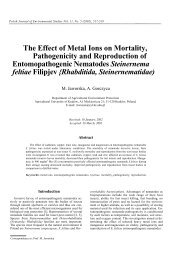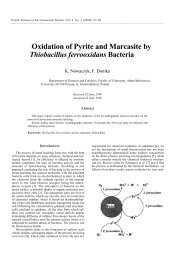Monitoring of Selected Heavy Metals Uptake by Plants and Soils in ...
Monitoring of Selected Heavy Metals Uptake by Plants and Soils in ...
Monitoring of Selected Heavy Metals Uptake by Plants and Soils in ...
You also want an ePaper? Increase the reach of your titles
YUMPU automatically turns print PDFs into web optimized ePapers that Google loves.
Polish Journal <strong>of</strong> Environmental Studies Vol. 9, No. 6 (2000), 511-515<br />
Letters to Editor<br />
<strong>Monitor<strong>in</strong>g</strong> <strong>of</strong> <strong>Selected</strong> <strong>Heavy</strong> <strong>Metals</strong> <strong>Uptake</strong><br />
<strong>by</strong> <strong>Plants</strong> <strong>and</strong> <strong>Soils</strong> <strong>in</strong> the Area<br />
<strong>of</strong> Toruń, Pol<strong>and</strong><br />
B. Buszewski*, A. Jastrzębska, T. Kowalkowski, A. Górna-B<strong>in</strong>kul<br />
Department <strong>of</strong> Environmental Chemistry <strong>and</strong> Ecoanalytics, Faculty <strong>of</strong> Chemistry,<br />
Nicholas Copernicus University, 7 Gagar<strong>in</strong> St, 87-100 Torun, Pol<strong>and</strong><br />
bbusz@chem.uni.torun.pl<br />
Received: July 7, 2000<br />
Accepted: July 26, 2000<br />
Abstract<br />
Environmental monitor<strong>in</strong>g <strong>of</strong> selected metals was performed us<strong>in</strong>g biota <strong>and</strong> soil samples. Sampl<strong>in</strong>g was<br />
carried out dur<strong>in</strong>g the period March-May <strong>and</strong> October-November. For the isolation <strong>of</strong> these analytes,<br />
conventional extraction <strong>and</strong> microwave m<strong>in</strong>eralization techniques were applied. Atomic Absorption Spectroscopy<br />
(AAS) equipped with Graphite Furnace (GF) was used to determ<strong>in</strong>e heavy metals <strong>and</strong> macroelements.<br />
The obta<strong>in</strong>ed data were compared with the respective values recommended <strong>by</strong> the Polish St<strong>and</strong>ards.<br />
Popular bio<strong>in</strong>dicators were used to estimate the level <strong>of</strong> pollution <strong>by</strong> heavy metals <strong>of</strong> Torun, Pol<strong>and</strong>.<br />
Application <strong>of</strong> the established sampl<strong>in</strong>g procedures for environmental samples <strong>and</strong> determ<strong>in</strong>ation methods<br />
for xenobiotics can be successfully applied for the purpose <strong>of</strong> rout<strong>in</strong>e analyses <strong>in</strong> biomonitor<strong>in</strong>g.<br />
Keywords: biomonitor<strong>in</strong>g, heavy metals, soil, plants<br />
Introduction<br />
The high concentration <strong>of</strong> heavy metals <strong>in</strong> soils is reflected<br />
<strong>by</strong> higher concentrations <strong>of</strong> metals <strong>in</strong> plants, <strong>and</strong><br />
consequently <strong>in</strong> animal <strong>and</strong> human bodies. The ability <strong>of</strong><br />
some plants to absorb <strong>and</strong> accumulate xenobiotics makes<br />
them useful as <strong>in</strong>dicators <strong>of</strong> environmental pollution. The<br />
study <strong>of</strong> excessive concentrations <strong>of</strong> pollutants <strong>in</strong> biological<br />
matrices has been reported <strong>in</strong> numerous publications<br />
[1-8]. P<strong>in</strong>e <strong>and</strong> spruce needles, mosses <strong>and</strong> grasses are<br />
widely used as a specific <strong>in</strong>dicator <strong>in</strong> the study <strong>of</strong> a geographical<br />
<strong>and</strong> temporal pattern <strong>of</strong> pollutants [9-12].<br />
Streit <strong>and</strong> Strumm [13] classified the exchange <strong>of</strong><br />
chemicals between soil <strong>and</strong> plants. They divided the most<br />
common methods <strong>of</strong> assess<strong>in</strong>g metal toxicity to plants<br />
from soil <strong>in</strong>to three categories <strong>in</strong> the conditions closed<br />
system:<br />
(i) monitor<strong>in</strong>g <strong>of</strong> the presence or absence <strong>of</strong> specific<br />
plant ecotypes <strong>and</strong>/or plant species (<strong>in</strong>dicator plant),<br />
* Correspond<strong>in</strong>g author<br />
(ii) measurements <strong>of</strong> metal concentration <strong>in</strong> tissues <strong>of</strong><br />
selected species (accumulative bio<strong>in</strong>dicators),<br />
(iii) record<strong>in</strong>g <strong>of</strong> physiological <strong>and</strong> biochemical responses<br />
(biomarkers) <strong>in</strong> sensitive bio<strong>in</strong>dicators.<br />
The aim <strong>of</strong> the present work was to <strong>in</strong>vestigate relations<br />
between contents <strong>of</strong> metals <strong>in</strong> soil <strong>and</strong> their accumulation<br />
<strong>in</strong> different morphological parts <strong>of</strong> plants. For<br />
this purpose, the concentrations <strong>of</strong> Pb, Zn, Cd, Cu, Fe,<br />
Ca, Mg <strong>in</strong> these matrices were measured. Popular bio<strong>in</strong>dicators<br />
<strong>in</strong>clud<strong>in</strong>g grasses, mosses, p<strong>in</strong>e needles were<br />
used for the estimation <strong>of</strong> heavy metals pollution <strong>of</strong><br />
Torun.<br />
Experimental<br />
Reagents <strong>and</strong> Apparatus<br />
Potassium chloride (POCh, Gliwice, Pol<strong>and</strong>) was used<br />
for soil acidity determ<strong>in</strong>ation. Nitric acid 0.5 M (POCh,<br />
Gliwice, Pol<strong>and</strong>) was used for the extraction <strong>of</strong> metals
512<br />
from soil. Solutions <strong>of</strong> 65% nitric acid, 30% hydrogen<br />
peroxide purchased from J.T. Baker (Deventer, the<br />
Netherl<strong>and</strong>s) were used for microwave digestion <strong>of</strong> tissue.<br />
Atomic absorption spectroscopy (AAS) analysis results<br />
for the extracts were compared with certificate reference<br />
soil <strong>and</strong> plant (Panalytica, Warsaw, Pol<strong>and</strong>). Calibration<br />
st<strong>and</strong>ards for AAS analysis were purchased from<br />
Aldrich-Chemie (Ste<strong>in</strong>heim, Germany).<br />
Instrumental analysis was carried out us<strong>in</strong>g the follow<strong>in</strong>g<br />
apparatus:<br />
(i) A set for microwave digestion consist<strong>in</strong>g <strong>of</strong> a rotor<br />
MDR 1000/6/100/110 (MDR Technology, Bergamo,<br />
Fig. 1. Localization <strong>of</strong> the sampl<strong>in</strong>g po<strong>in</strong>ts <strong>of</strong> plants <strong>and</strong> soil.<br />
Italy) <strong>and</strong> a Samsung microwave oven <strong>of</strong> RE 1200 type<br />
(Seoul, Korea);<br />
(ii) A PU 9100x atomic absorption spectrophotometer<br />
with a graphite cuvete <strong>and</strong> autosampler (Philips, Cambridge,<br />
Engl<strong>and</strong>);<br />
(iii) pH meter N5170E (Teleko, Warsaw, Pol<strong>and</strong>).<br />
Sample Collection Procedure<br />
Buszewski B.et al.<br />
Soil <strong>and</strong> plant samples (needles P<strong>in</strong>us silvestris L.,<br />
grass Festuca protensis L., moss Pleurozium schreberi)
<strong>Monitor<strong>in</strong>g</strong> <strong>of</strong> <strong>Selected</strong> ...<br />
were collected from different sites (Fig. 1) dur<strong>in</strong>g a few<br />
years every March-April <strong>and</strong> October-November. Totally,<br />
thirty samples were taken out from the chosen <strong>and</strong><br />
marked rectangles 50x100 m. The surface soil samples<br />
were from 0-20 cm depth. Clark's procedure [14] for<br />
evaluation <strong>of</strong> homogenity <strong>of</strong> environmental samples has<br />
been used to f<strong>in</strong>d out the optimal number at sampl<strong>in</strong>g<br />
sites to characterize the <strong>in</strong>vestigated area. Precision <strong>of</strong><br />
the analytical results was calculated as the coefficients <strong>of</strong><br />
variation.<br />
Sample Preparation<br />
The soil samples were dried at a room temperature<br />
for 7 days <strong>and</strong> sieved (2 mm sieve). The dried samples<br />
were subjected to a cool extraction with 0.5 M HNO3 for<br />
30 m<strong>in</strong>utes [15-16]. Pb, Zn, Cu, Mg, Fe <strong>and</strong> Ca were<br />
determ<strong>in</strong>ed <strong>by</strong> acetylene-air flame atomic absorption<br />
spectrophotomectry <strong>and</strong> Cd was determ<strong>in</strong>ed <strong>by</strong> graphite<br />
furnace atomic absorption spectrophotometry. The pH<br />
levels <strong>of</strong> soil layers were also measured.<br />
Samples <strong>of</strong> grasses, mosses <strong>and</strong> p<strong>in</strong>e needles were<br />
dried for 14 days at room temperature. Experimental<br />
plant material was not washed. The needles from<br />
different years were first segregated. The samples were<br />
microwave digested <strong>and</strong> the determ<strong>in</strong>ation <strong>of</strong> selected<br />
heavy metals was done us<strong>in</strong>g AAS, FG/AAS [17-18]. The<br />
oxidiz<strong>in</strong>g medium was 65% HNO3 (3 ml) <strong>and</strong> 30% H2O2<br />
(1 ml). The m<strong>in</strong>eralization conditions are presented <strong>in</strong><br />
Table 1 [19].<br />
All results obta<strong>in</strong>ed were statistically analyzed <strong>and</strong><br />
calculated as a dry mass.<br />
Table 1. The procedure <strong>of</strong> microwave m<strong>in</strong>eralization [19].<br />
Results <strong>and</strong> Discussion<br />
The results <strong>of</strong> the heavy metal concentrations determ<strong>in</strong>ed<br />
<strong>in</strong> plant tissues <strong>and</strong> <strong>in</strong> top layers <strong>of</strong> soils are presented<br />
<strong>in</strong> Tables 2-4.<br />
Table 2. Concentration <strong>of</strong> selected metals (mg/kg soil) <strong>in</strong> soil collected <strong>in</strong> 1999 year <strong>in</strong> Torun (n - number <strong>of</strong> sampl<strong>in</strong>g)<br />
513
514<br />
The pH values <strong>of</strong> soils presented <strong>in</strong> Table 2 classified<br />
them as acidic. The pH <strong>of</strong> spr<strong>in</strong>g samples is <strong>of</strong>ten higher<br />
than the autumn samples. The amount <strong>of</strong> acid accumulated<br />
<strong>in</strong> soil can be expla<strong>in</strong>ed <strong>by</strong> the liberation <strong>of</strong> acids <strong>by</strong><br />
plant at the beg<strong>in</strong>n<strong>in</strong>g <strong>of</strong> the vegetation cycle <strong>and</strong> start<strong>in</strong>g<br />
soil-decomposition process.<br />
The concentration <strong>of</strong> analyzed metals shows some diversity<br />
<strong>in</strong> the studied area. The highest concentrations<br />
were observed for macroelements (Fe, Ca, Mg). These<br />
result from physicochemical properties <strong>of</strong> the <strong>in</strong>vestigated<br />
soils. In case <strong>of</strong> trace heavy metals, the highest<br />
difference between the m<strong>in</strong>imum <strong>and</strong> maximum value<br />
noticed was for Zn (119 mg/kg dry mass <strong>in</strong> autumn<br />
samples <strong>and</strong> 33 mg/kg <strong>in</strong> spr<strong>in</strong>g sample). The small difference<br />
for the spr<strong>in</strong>g samples can be expla<strong>in</strong>ed <strong>by</strong> an<br />
<strong>in</strong>tensive cumulat<strong>in</strong>g <strong>of</strong> the elements <strong>by</strong> biota. The decrease<br />
<strong>in</strong> heavy metals concentration <strong>in</strong> soil samples from<br />
spr<strong>in</strong>g samples was observed.<br />
The concentration <strong>of</strong> heavy metals <strong>in</strong> the exam<strong>in</strong>ed<br />
soils did not exceed the limited values for agricultural<br />
soils (accord<strong>in</strong>g to Polish Norms) [20].<br />
The applied acidic extraction allows for the determ<strong>in</strong>ation<br />
<strong>of</strong> total metal concentrations <strong>in</strong> soil. The values <strong>of</strong><br />
total concentration <strong>of</strong> heavy metals were related to its<br />
uptake <strong>by</strong> plants [16].<br />
The metal concentrations <strong>in</strong> biosensors, i.e. grasses,<br />
mosses <strong>and</strong> p<strong>in</strong>e needles, similarly to soil, show differences<br />
(Table 4). The observed differences between m<strong>in</strong>imum<br />
<strong>and</strong> maximum values (for example: grasses Pb - 3,<br />
Cu - 35, Zn - 75, Fe - 499, Ca - 5615, Mg - 2315 mg/kg<br />
dry mass) are related to a different pollution level <strong>of</strong> the<br />
exam<strong>in</strong>ed places. The highest concentration <strong>of</strong> heavy<br />
metals were found <strong>in</strong> plants collected dur<strong>in</strong>g spr<strong>in</strong>gtime<br />
(Fig. 2) <strong>and</strong> from the areas localised near high traffic<br />
streets, <strong>and</strong> residential <strong>and</strong> commercial area with a heavy<br />
use <strong>of</strong> heat<strong>in</strong>g appliances (Fig. 1).<br />
Generally, the concentrations <strong>of</strong> selected metals <strong>in</strong><br />
plants are <strong>in</strong> the range <strong>of</strong> values recommended <strong>by</strong> the<br />
Polish Norms [20]. Only <strong>in</strong> the case <strong>of</strong> lead does the<br />
mean concentration exceed the admissible st<strong>and</strong>ard<br />
(limited value - 10 mg/kg dry mass). Special attention<br />
should be given to a considerable accumulation <strong>of</strong> Pb <strong>in</strong><br />
grasses. The maximum detected concentration was four<br />
times higher than the permitted value. It is important to<br />
notice that this element negatively <strong>in</strong>fluences the physiological<br />
processes <strong>of</strong> plants.<br />
Analysis <strong>of</strong> metal uptake <strong>by</strong> plants serv<strong>in</strong>g as biosensors<br />
permits us evaluation <strong>of</strong> pollution <strong>in</strong> the studied<br />
area. The concentration <strong>of</strong> metals <strong>in</strong> grasses was proportional<br />
to those <strong>in</strong> soil (Fig. 3). A variance analysis<br />
(Scheffe's test) was performed to evaluate correlations <strong>in</strong><br />
plant soil system us<strong>in</strong>g StatS<strong>of</strong>t Statistica 5.0 [21]. L<strong>in</strong>ear<br />
correlation coefficients show a dist<strong>in</strong>ct dependence<br />
between content <strong>of</strong> heavy metals <strong>in</strong> plants <strong>and</strong> soils<br />
(Table 4).<br />
Correlation <strong>and</strong> regularities <strong>in</strong> the accumulation <strong>of</strong><br />
selected metals <strong>in</strong> biota (results from years 1995 - 1998)<br />
are presented (Fig. 4).<br />
It can be noticed that the metal contents <strong>in</strong> grasses<br />
were almost unchanged dur<strong>in</strong>g the study period. The<br />
mean concentrations <strong>of</strong> these elements were as follows:<br />
Pb - 25, Cu - 20, Zn - 83 mg/kg dry mass. The small<br />
differences <strong>of</strong> values can be caused <strong>by</strong> changes <strong>of</strong><br />
Table 4. L<strong>in</strong>ear correlation coefficients (R 2 ) for comparison <strong>of</strong><br />
the total content <strong>of</strong> heavy metals <strong>in</strong> plants <strong>and</strong> soils (n=31),<br />
p = 0.05<br />
Fig. 2. Concentration <strong>of</strong> heavy metals <strong>in</strong> grasses (number <strong>of</strong><br />
samples, n = 36) sampled <strong>in</strong> autumn <strong>and</strong> spr<strong>in</strong>g.<br />
Fig. 3. Comparison <strong>of</strong> Pb concentration <strong>in</strong> soil <strong>and</strong> <strong>in</strong> grass<br />
samples collected <strong>in</strong> Torun (p=0.02), R 2 = 0.9520.<br />
Buszewski B.et al.<br />
Fig. 4. Comparison <strong>of</strong> the content <strong>of</strong> heavy metals <strong>in</strong> grasses <strong>in</strong><br />
1995-1998.
<strong>Monitor<strong>in</strong>g</strong> <strong>of</strong> <strong>Selected</strong> ...<br />
environmental, <strong>and</strong> atmospheric conditions as well as<br />
pollution levels (traffic <strong>in</strong>tensity <strong>and</strong> conditions <strong>in</strong> a given<br />
area).<br />
Conclusions<br />
Our study proves that plants selected <strong>by</strong> us accumulate<br />
metals (heavy metals <strong>and</strong> macroelements) <strong>in</strong> assimilation<br />
organs <strong>and</strong> roots. Thus, they can be recommended<br />
as <strong>in</strong>dicators for determ<strong>in</strong>ation <strong>of</strong> pollution levels <strong>of</strong> the<br />
environment.<br />
The metal concentrations <strong>in</strong> soils <strong>of</strong> the measured<br />
area (Toruii, Pol<strong>and</strong>) did not exceed the limited values<br />
recommended <strong>by</strong> the Polish St<strong>and</strong>ards for agricultural<br />
soils [22]. Lower amounts <strong>of</strong> heavy metals <strong>in</strong> soil samples<br />
taken <strong>in</strong> spr<strong>in</strong>g were observed.<br />
The contents <strong>of</strong> metals <strong>in</strong> exam<strong>in</strong>ed plants (grasses,<br />
mosses, p<strong>in</strong>e needles) were lower than permitted concentrations,<br />
except lead <strong>in</strong> grasses <strong>and</strong> mosses. Generally,<br />
the concentration <strong>of</strong> metals decreased with <strong>in</strong>creas<strong>in</strong>g<br />
distance from the pollutant emission sources.<br />
Grasses do absorb the contam<strong>in</strong>ants dur<strong>in</strong>g their relatively<br />
short vegetation period, i.e. spr<strong>in</strong>g-autumn. The<br />
concentrations <strong>of</strong> heavy metals <strong>in</strong> grasses were proportional<br />
to those <strong>in</strong> soil. For that reason they are very good<br />
<strong>in</strong>struments - biosensors - for observation <strong>of</strong> the trends<br />
<strong>in</strong> soil composition <strong>of</strong> pollutants.<br />
The results <strong>of</strong> <strong>in</strong>vestigation were optimization <strong>of</strong><br />
sampl<strong>in</strong>g methods for biological samples <strong>and</strong> determ<strong>in</strong>ation<br />
methods for xenobiotics <strong>in</strong> soil <strong>and</strong> plants. Application<br />
<strong>of</strong> the established sampl<strong>in</strong>g procedures <strong>and</strong> determ<strong>in</strong>ation<br />
methods for xenobiotics <strong>in</strong> environmental samples<br />
can be successfully applied for the purpose <strong>of</strong> rout<strong>in</strong>e<br />
analyses <strong>in</strong> biomonitor<strong>in</strong>g.<br />
This result will serve as a pilot study for further <strong>in</strong>vestigation<br />
<strong>of</strong> plant species <strong>in</strong> bio<strong>in</strong>dication <strong>of</strong> environmental<br />
pollution. We will cont<strong>in</strong>ue this trend <strong>of</strong> <strong>in</strong>vestigations<br />
<strong>in</strong> our future work.<br />
Acknowledgement<br />
This work was supported <strong>by</strong> the Polish Committee for<br />
Scientific Work (KBN, Warsaw, Pol<strong>and</strong>) <strong>and</strong> the government<br />
<strong>of</strong> Toruh.<br />
References<br />
1. MCCRADY J. K., MAGGARD S. P., <strong>Uptake</strong> <strong>and</strong> photo-<br />
degradation <strong>of</strong> 2,3,7,8-tetra chlorodibenzeno-p-diox<strong>in</strong><br />
sorbed to grass foliage, Environ. Sci. Techol., 27, 343, 1993.<br />
2. A. JASTRZEBSKA, B. BUSZEWSKI, Zastosowanie<br />
biomonitor<strong>in</strong>gu w ekoanalityce, Chemia i Inzynieria<br />
Ekologiczna, 11, 1097, 1999.<br />
3. HAUK H., UMLAUF G, MCLACHLAN S., <strong>Uptake</strong> <strong>of</strong> gas<br />
eous DDE <strong>in</strong> spruce needles, Environ. Sci. Technol., 28,<br />
2372, 1994.<br />
515<br />
4. FARAGO M. E., <strong>Plants</strong> as <strong>in</strong>dicators <strong>of</strong> m<strong>in</strong>eralisation <strong>and</strong><br />
pollution, <strong>in</strong>: <strong>Plants</strong> <strong>and</strong> the Chemical Elements, VCH,<br />
Wienheim, 221, 1994.<br />
5. GORNA-BINKUL A., KEYMEULEN R., VAN LANGEN-<br />
HOVE H., BUSZEWSKI B., Determ<strong>in</strong>ation <strong>of</strong> monocyclic<br />
aromatic hydrocarbons <strong>in</strong> fruit <strong>and</strong> vegetables <strong>by</strong> gas<br />
chromatography-mass spectrometry, J. Chromatogr. A, 734,<br />
297, 1996.<br />
6. PANDOLFINI T., GREMIGNI P., GABBRIELLI R., Bi<br />
omonitor<strong>in</strong>g <strong>of</strong> Soil Health <strong>by</strong> <strong>Plants</strong>, <strong>in</strong>: Biological Indicator<br />
<strong>of</strong> Soil Health <strong>and</strong> Susta<strong>in</strong>able Productivity, CAB Interna<br />
tional, 325, 1997.<br />
7. BERTHELSEN B.O, STEINNES E., SOLBERG W., JIN-<br />
GSEN L., <strong>Heavy</strong> metals concentrations <strong>in</strong> plants relation to<br />
atmospheric heavy metals deposition, J. Environ. Qual., 24,<br />
1018, 1995.<br />
8. NAMIESNIK J., WARDENCKI W, Wykorzystanie<br />
rosl<strong>in</strong>nosci w biomonitor<strong>in</strong>gu srodowiska, Chemia<br />
i Inzynieria Ekologiczna 3, 189, 2000.<br />
9. RICHARDSON D. H. S., Metal <strong>Uptake</strong> <strong>in</strong> Lichens, Symbio<br />
sis, 18,119, 1995.<br />
10. BARGAGLI R., BROWN D. H., NELLI L., Metal bi<br />
omonitor<strong>in</strong>g with mosses: procedures for correct<strong>in</strong>g for soil<br />
contam<strong>in</strong>ation, Environ. Pollut., 89, 169, 1995.<br />
11. JASTRZEBSKA A., KOWALKOWSKI T., GORNA-BI<br />
NKUL A., BUSZEWSKI B., Biowskazniki w ocenie stopnia<br />
skazenia srodowiska. Modele sorpcji zanieczyszczen, <strong>in</strong>:<br />
Zwiazki organiczne w srodowisku i metody ich oznaczania,<br />
BMS, Warszawa, 135, 1998.<br />
12. JENSEN S., ERIKSSON G., KYLIN H. Atmospheric <strong>by</strong><br />
persistent organic compounds: monitor<strong>in</strong>g with p<strong>in</strong>e needles,<br />
Chemosphere, 24, 229, 1992.<br />
13. STREIT B., STRUMM W., Chemical properties <strong>of</strong> metals<br />
<strong>and</strong> the process <strong>of</strong> bioaccumulation <strong>in</strong> terrestrial plants, <strong>in</strong><br />
<strong>Plants</strong> as Biomonitors, <strong>in</strong>: Indicators for <strong>Heavy</strong> <strong>Metals</strong> <strong>in</strong> the<br />
Terrestial Environment, VCH, We<strong>in</strong>heim, 381, 1993.<br />
14. SIENKIEWICZ J., Forest site bio<strong>in</strong>dications with plant<br />
chemistry representatives <strong>of</strong> plant material sampl<strong>in</strong>g, Och-<br />
rona srodowiska i zasobow naturalnych, 14, 43, 1998.<br />
15. RAUTER G., Extraction procedures for the determ<strong>in</strong>ation<br />
<strong>of</strong> heavy metals <strong>in</strong> contam<strong>in</strong>ed soil <strong>and</strong> sediment, Talanta,<br />
46, 449, 1998.<br />
16. NOVOZAMSKY I, LEXMOND T. H. M., HOUBA V. J.<br />
G., A s<strong>in</strong>gle extraction procedure <strong>of</strong> soil for evaluation <strong>of</strong><br />
uptake <strong>of</strong> some heavy metals <strong>by</strong> plants, J. Environ. Anal.<br />
Chem., 55, 47, 1993.<br />
17. BROOKS R.R., <strong>Plants</strong> that Hyperaccumulate <strong>Heavy</strong> <strong>Metals</strong>,<br />
CAB International, 95, 1997.<br />
18. GZYL J., Lead <strong>and</strong> cadmium contam<strong>in</strong>ations <strong>of</strong> soil <strong>and</strong><br />
vegetables <strong>in</strong> the upper region <strong>of</strong> Pol<strong>and</strong>, Sci. Total En-<br />
vironm., 96, 199, 1990.<br />
19. SZABLEWSKI L., JASTRZEBSKA A., BUSZEWSKI B.,<br />
Microwave methods <strong>of</strong> sample preparation for the purposes<br />
<strong>of</strong> environmental analysis, Polish J. Environ. Studies, 5, 13,<br />
1997.<br />
20. Monitor Polski nr 22 (11.05.1993).<br />
21. SIENKIEWICZ J., Assessment <strong>of</strong> <strong>in</strong>dicatory role <strong>of</strong> bilberry<br />
(Vacc<strong>in</strong>ium myrtillus L.) <strong>in</strong> bio<strong>in</strong>dication <strong>of</strong> site pollution,<br />
Ochrona srodowiska i zasobow naturalnych 15, 29, 1998.<br />
22. KABATA-PENDIAS A., PENDIAS H, Biogeochemia pier-<br />
wiastkow sladowych, PWN, Warszawa, 53, 1995.


